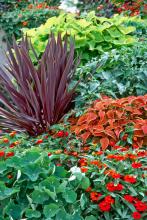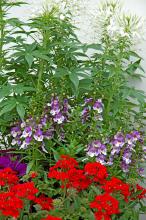Information Possibly Outdated
The information presented on this page was originally released on March 1, 2007. It may not be outdated, but please search our site for more current information. If you plan to quote or reference this information in a publication, please check with the Extension specialist or author before proceeding.
Break the horizontal planes in '07 gardens
By Norman Winter
MSU Horticulturist
Central Mississippi Research & Extension Center
Spring is just around the corner, and this is a good time for gardeners to make plans to break the horizontal plane in their 2007 landscapes.
Most everyone grows round flowers like the ones we first encountered as children. A bed of round flowers offers a calming continuity to the garden, which can be comforting after a hard, stressful week.
Here is what I mean about breaking the horizontal plane: Imagine a 10-foot-long bed with some great new selections of lantanas brimming with butterflies and hummingbirds. If you tied a string from one end of the bed to the other just at the top of the lantanas, you would have the imaginary horizontal plane. Using additional flowers that spike up above this plane creates excitement and added interest.
These types of flowers can be planted behind the lantanas if they are tall enough, or in informal drifts to break up the continuous pattern of the round-flowered lantanas, verbenas, petunias or other predominate flowers.
There are certainly some good choices of flowers that will give a long season of color. One of my top picks would be the Mystic Spires Blue salvia.
Mystic Spires Blue is an Indigo Spires selection. It has a bushier, better branching habit that yields colorful blue flowers all summer. Expect the plants to be in the 4-foot range.
Another to consider is the angelonia, also known as summer snapdragon. The angelonia started showing up in garden centers around 1997, but it is still not used nearly enough.
The industry did not help matters. After a few years of marketing the plants as angelonias, they changed and started calling them summer snapdragons. This reduced the name recognition for angelonias.
Angelonias have only gotten better over the years from the standpoint of color and performance. We now have them ranging in height from 15 inches, like the new Serena series, to 18 to 20 inches with the Angle Mist Compact, and the taller selections like Angel Face that top out around 24 to 28 inches.
One of the new ones to look for this spring is Angel Face Wedgwood Blue. This one is as pretty as fine china. It is a bi-colored bluish-purple and white selection. The Angel Face varieties have garnered awards from Michigan to Texas.
Foliage also can be useful for breaking the horizontal plane. One of the hottest plants around for this is the Red Star cordyline. This plants looks like a red dracaena and with great drainage, is cold hardy from zones 7 to 9. Look also for Red Sensation.
The plants have distinct, sword-like, reddish-purple leaves and will reach around 3 feet in height. The plants need a lot of sun to maintain this incredible color. Do not let them dry out between waterings.
Botanically speaking, it is Cordyline australias. Not only is it one of the hottest plants in the nation, but it also was flying off the shelves at the 2007 Gulf Coast Garden and Patio Show in Biloxi. I expect them to be in good supply for the 10th Jackson Garden and Patio Show March 16-18 at the Mississippi Trade Mart.
Break the horizontal plane this spring, and you'll be smiling from ear to ear.




